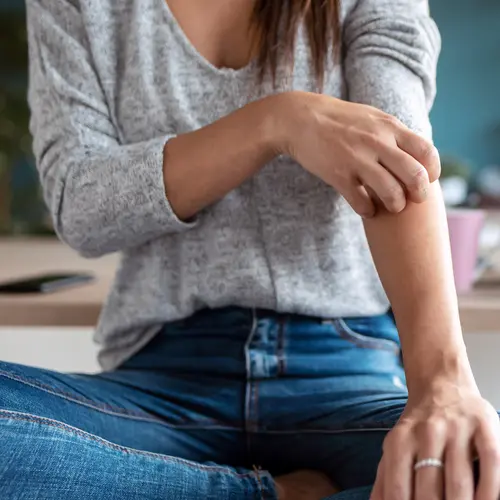Rosacea and psoriasis are both common skin conditions that can cause some similar symptoms. It can be hard to know which one you have without talking to your doctor, but there are some key differences that can help you tell one from the other.
Symptoms
Rosacea and psoriasis are both lifelong conditions with symptoms that come and go. Most people have flare-ups and more mild periods called remissions.
Rosacea usually affects the skin at the center of your face, especially your cheeks, nose, and chin. Signs include:
- Flushing or redness, sometimes with blood vessels you can see. It may look like a sunburn that doesn’t go away.
- Bumps and pimples
- The skin of the nose can get thicker.
- Stinging, burning, or tightness of skin
- Swelling
- Dry, rough, or scaly-feeling skin
For some people, rosacea can affect the eyes, causing symptoms like redness, burning, watery eyes, and swollen eyelids.
Psoriasis, though, can happen anywhere on your body. But when it appears on your face, it’s usually in the eyebrows, around the nose, and at the top of the forehead in the hairline. The symptoms can look similar to rosacea:
- Red patches
- Dryness
- Itching or burning
- White bumps filled with pus
But people with psoriasis often have other symptoms that don’t happen with rosacea, including:
- Changes in your fingernails or toenails
- Raised patches with silvery scales, called plaques
- Symptoms in other places, like your elbows or knees
- Signs of arthritis, such as stiff joints or back pain
Triggers
Rosacea and psoriasis have some of the same triggers: stress, some medications, alcohol, changes in the weather, and for some people, allergies or certain foods. Psoriasis can also be triggered by infections and skin injuries.
It’s more likely you have rosacea if your symptoms start or get worse because of:
- Sun exposure, even without sunburn
- Wind
- Heavy exercise
- A hot bath
- Alcohol
- Spicy food
- Indoor heat
- Hot drinks
- Cosmetics
Causes
Doctors aren’t sure exactly why people get rosacea or psoriasis. But both conditions tend to run in families. Problems with the immune system also seem to play a role.
In psoriasis, the immune system overreacts, causing the body to make more skin cells faster, which makes the skin get thicker.
There are several theories about the causes of rosacea. One is that the immune system may overreact to a certain type of bacteria, Bacillus oleronius. Another idea is that it may come from a problem with the blood vessels under the skin. It may also have to do with the way the body processes cathelicidin, a protein that protects the skin from infection. Or people with rosacea may have more of a tiny mite, called demodex, which lives on everyone’s skin.
Treatments
Over three-quarters of people with rosacea or psoriasis don’t get treatment. But both conditions can affect your everyday life and are likely to get worse over time. There are many treatments for both. If you suspect you have rosacea or psoriasis, talk with your doctor about your symptoms.
For either condition, doctors usually recommend medications you rub on your skin, such as lotions, creams, gels, liquids, or shampoos. You may also take pills that tamp down inflammation and help calm your immune system.
Light can also be a treatment for both conditions. Though sunlight is a common trigger for rosacea, two types of light therapy -- laser therapy and intense pulsed light therapy -- can ease redness by removing visible blood vessels.
Light therapy is a common treatment for psoriasis plaques. Ultraviolet B (UVB) light can slow the growth of affected skin cells. This type of light is part of sunlight, but it’s safer and more effective to get this type of light from a laser or a device you use indoors. Your doctor can tell you where to get one.
Lifestyle Changes
On top of medical treatments, many lifestyle changes can ease symptoms of rosacea and psoriasis:
- Quit smoking.
- Find ways to lower stress.
- Drink less alcohol.
- Eat a healthy diet.
- Exercise. If it triggers your rosacea symptoms, do it before sunrise or after sunset and at low to medium intensity.
- Practice gentle skin care.
- Use mild cosmetics and good moisturizers.
- Take steps to avoid sunburn, like using sunscreen with a physical blocker, like zinc oxide, and an SPF of 30 or higher.

